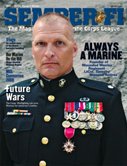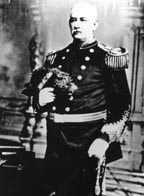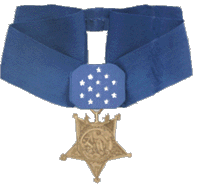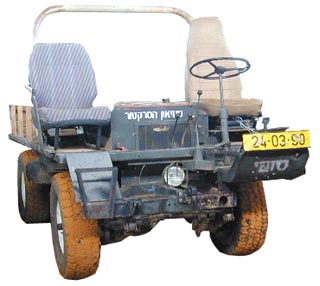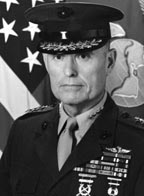
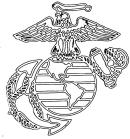
|
|
|
|
|
|
M1 |
The U.S. rifle caliber .30 [30-06], M1, is an air-cooled, gas-operated, clip-fed, semiautomatic shoulder weapon. The primary infantry weapon of World War II and Korea. It replaced the Springfield M1903 and was replaced by the M14. |
|
M1/M2 |
.30 cal. carbine rifle. |
|
M103 |
Heavy gun tank with a 120 mm main cannon of extremely long range. |
|
M14 |
The U.S. rifle, caliber 7.62 mm [308 Winchester], M14, is an air-cooled, gas-operated, magazine-fed, shoulder weapon. It is designed primarily for semiautomatic fire. An infantry weapon in use between Korea and early Vietnam. It replaced the M1 and was replaced by the M16. |
|
M15 |
White phosphorous hand grenade replaced by the M34. |
|
M16 |
The U.S. rifle, caliber 5.56 mm [223 Remington], M16, is a lightweight air cooled, gas operated, magazine fed, shoulder weapon. It is capable of both semiautomatic and full automatic fire. The basic infantry rifle that replaced the M14 at the start of the Vietnam War. It was designed by Eugene Stoner for the Armalite Company and was produced by Colt. See Mattel. |
|
M170 |
Bipod for the M224 mortar. |
|
M18 |
Colored Smoke Hand Grenade. Emits either red, green or yellow smoke for up to 1.5 minutes. Color is marked on the canister. |
|
M1903 |
Springfield
bolt-action .30 cal rifle which was replaced by the M1 in the mid
1930s. The Marine Corps used them into World War II. |
|
The automatic pistol, caliber 45 is a recoil operated, magazine fed hand weapon. Used from World War I until the 1990s, it has been replaced by the M9. |
|
|
M1917A1 |
Browning water cooled machine gun. |
|
M1918 |
Browning Automatic Rifle, known universally as the BAR. |
|
M1919A4 |
Browning .30 cal. machine gun. |
|
M2 |
"Heavy barrel" .50 cal. machine gun developed just after WWI and still being used into the 21st Century. |
|
M203 |
Light weight, single-shot, breech-loaded, pump action (sliding barrel), shoulder-fired weapon attached to the M16A2 rifle. |
|
M224 |
60 mm Mortar consisting of the M225 cannon, the M170 bipod and the M64 sight as well as two types of base plates, the circular M7 and the rectangular M8. |
|
M225 |
Cannon for the M224 mortar. |
|
M228 |
Hand grenade fuse. |
|
M249 |
SAW or Squad Automatic Weapon, it replaced the BAR. The SAW is a gas-operated, belt/magazine-fed, aircooled, automatic, shoulder-fired weapon 5.56 mm. Typically there are nine SAWs in a basic infantry platoon. |
|
M25A2
CS |
Riot Control Hand Grenade weighing 7.5 oz with 3.5 oz of CS gas with a unique arming system unlike any other grenade in the inventory. The use and effect is the same as the M7A3. |
|
M26 |
Fragmentation hand grenade. Hand-thrown with a 7-second delay from arming to explosion. |
|
M34 |
White phosphorous smoke hand grenade. This 27.2 oz weapon contains 12 oz of white phosphorous. |
|
M3A1 |
Shoulder fired, blowback operated .45 cal. submachinegun with 30-round magazine known as the "grease gun". A favorite of garrison officers. Standard on-board weapon for most tank crews. |
|
M47 |
Dragon Weapon System. Man-portable, shoulder-fired, medium range antitank weapon. |
|
M48A3 |
Main battle tank in Vietnam with a 90 mm main gun, coaxial mounted .30 cal machine gun and a coupola mounted .50 cal. machine gun with a crew of 4. The 850 horse Chrysler air-cooled diesel engine provided a crusing range of approximately 200 miles. It weighed 52 tons combat loaded. |
|
M60 |
Air cooled, belt fed, gas-operated, fully automatic, shoulder-fired standard infantry machine gun 7.62 mm with bipod and replacement barrels. |
|
M64 |
Sight for the M224 mortar. |
|
M67 |
Fragmentation hand grenade. This 14 oz hand weapon contains 6.5 oz of composition B. The average Marine can throw it 40 meters and it has a casualty producing radius of 15 meters. |
|
Flame thrower tank with 260 gallon bottle of napalm, a coaxial mounted .30 cal. machine gun and a crew of three. It had a cruising range of 200 miles and weighed 50 tons combat loaded. |
|
|
M69 |
Training and practice grenades. The training version has all inert or expended parts, the only removable item is the pin. The practice grenade is the same as the training grenade except that it uses an active M228 fuse to indicate delay times and add realism to training. |
|
M7 |
Larger, circular baseplate for the M224 mortar. |
|
M79 |
Shoulder-held, 40 mm, single shot grenade launcher with a range of 400 meters. Called a "blooper" from the sound it made when fired. |
|
M7A3 CS |
Riot Control Hand Grenade. This 19 oz weapon contains 9.5 oz of CS that when ignited gives off a thick cloud of irritating agent for approximately 60 seconds. |
|
M8 |
Smaller, rectangular baseplate for the M224 mortar. |
|
M9 |
Baretta 9mm pistol with 15 round magazine which replaced the M19llA1 in the 1990s. |
|
MAG |
Marine Air Group. A unit in an air wing equivalent to an infantry regiment. Commanded by a colonel. |
|
Maggie’s
Drawers |
A red flag waved from the rifle pits (or butts) to indicate a complete miss of the target during qualification firing. |
|
Maggot |
One of the lowest forms of life. Also a Marine who spends most of his or her time trying to obtain a discharge. |
|
Marine Air Ground Task Force. A unit with both air and ground elements but not MEU or MEB. |
|
|
Mail
Buoy |
A non-existent navigational aid used in a practical joke by "salty" Marines and sailors. Allegedly, the mail buoy or sea buoy was a device to which passing ships or aircraft would attach packets of mail. Inexperienced Marines or sailors were assigned to "guard duty" and told to be on the look out for the buoy. It was part of an informal initiation rite. |
|
Main
Bottle |
360 gallon
bottle of napalm on the M67A2 flame thrower tank. A cluster of nine air
bottles surrounded the main bottle to provide air for propulsion. |
|
Mainside |
The main portion of a base or installation where the headquarters are located along with the Marine Corps Exchange and theater. As opposed to “in the field” or the boonies. |
|
Major |
The fourth
grade of commissioned officer and first of the field grades is
indicated by a gold oak leaf on the collar points. The pay grade is O-4
and is the same in the Army and Air Force. In the Navy and Coast Guard
the rank is lieutenant commander and is additionally indicated with two
broad bands of gold with one narrow band between them topped with an
insignia representing the branch to which the officer is assigned (most
often a gold star in the Navy) or a gold shield in the Coast Guard. |
|
Second of the flag officer ranks indicated by two silver stars on the collar points of the uniform. The pay grade is O-8 and is the same in the Army and the Air Force. In the Navy and Coast Guard the rank is rear admiral (upper half) and is additionally indicated with a two inch gold band and two one inch gold bands and a gold star (Navy) or gold shield (Coast Guard) above on the coat cuffs. The shoulder board is the same as rear admiral (lower half) except that there are two silver stars rather than one. |
|
|
Make a
hole |
A phrase used to move a group of people not in formation out of the way of a formed unit or a person senior in rank. |
|
Malingerer |
A Marine or recruit who spends too much time at sick call or makes other excuses to get out of training or duty. It is a punishable offense under the UCMJ. |
|
A problem in Marine Corps recruit training in the middle of the 20th Century, now resolved. Recruit training, while difficult and demanding, is not life threatening. Each of the very few accidents is thoroughly investigated and reviewed. See Ribbon Creek. |
|
|
Mameluke
Sword |
The sword worn
on parade and formal occasions by Marine |
|
Manning
the Rails |
When entering or leaving port or when rendering special honors the ship's compliment will dress in full dress uniforms and stand along the rails or in the rigging at the position of attention. |
|
Manual
of Arms |
The prescribed movements involving the use of weapons, including swords, in parades and ceremonies. |
|
MarDet |
Marine Detachment. |
|
The United States Marine Band, "The President's Own," is located at Marine Barracks 8th and I, Washington, DC. It is the official band of the Marine Corps. Other bands exist at division, air wing and depot levels throughout the Marine Corps. |
|
|
Marine
Brat |
See Military Brat. |
|
Marine
Combat Training |
Infantry training provided to every Marine not assigned an Infantry MOS. See School of Infantry. |
|
At Guantanamo
Bay, Cuba 25 April 1913, Marines of the Second Provisional Brigade
formed the Marine Corps Association. John A. Lejeune,
then a lieutenant colonel, headed its first executive committee. The
purpose of the MCA was defined then and continues to drive the
Association. To disseminate knowledge of the military art and science
among members. · To
provide for professional advancement. · To
foster the spirit and preserve the traditions of the Marine Corps. · To increase the efficiency of the Marine Corps and to further the interest of the military and Naval Services in all ways not inconsistent with the good of the general government. |
|
|
Marine
Corps Birthday Ball |
Any event from a buffet dinner to a mess night held on or close to November 10th each year to commemorate the birthday of the United States Marine Corps in 1775. To qualify it must have a decorated cake so that the first two pieces go to the oldest and youngest Marine present and the reading of the Commandant’s Birthday Order and the Birthday Order of Major General Commandant John A. Lejeune. |
|
The correct name of the PX. On Navy bases you will find a Navy Exchange and on Army and Air Force installations they will have Army and Air Force Exchange Service (AAFES). |
|
|
The magazine for professional Marines. |
|
|
Marine
Corps Hymn |
See Marines' Hymn. The Marine Corps Hymn is the Navy Hymn, sung or played to the tune of Eternal Father, including a final verse: Eternal
Father, grant, we pray, |
|
National organization of Marines and former Marines with local detachments throughout the country. |
|
|
Marine
Detachment |
A small unit of Marines assigned as part of the ship's compliment to provide guard duties, operate the brig, provide orderlies to the senior Navy officers and man one or more of the guns on board. See Seagoing Marine. |
|
Marine
Expeditionary Brigade (MEB) |
Consisting of a Regimental Landing Team, Marine Air Group and a services support group the MEB is commanded by a brigadier general and is a self-sufficient fighting element. |
|
Marine
Expeditionary Force (MEF) |
Built around a complete Division-Wing team with combat support and combat service support groups, the MEF consists of about 53,000 Marines and sailors. |
|
Marine
Expeditionary Unit (MEU) |
The smallest of the expeditionary organizations is built around a Battalion Landing Team and a Composite Air Squadron. It consists of approximately 2,500 Marines. |
|
Marine
House |
Used often in embassy duty to designate the residence for Marines located in a civilian neighborhood overseas or on the grounds of an embassy. Sometimes generally used for any free-standing barracks for Marines. |
|
Marine
One |
The call sign of the Marine aircraft in which the President of the United States is either passenger or pilot. Usually one of the specially built helicopters assigned to Andrews Air Force Base, Md. for Presidential Support. Most often used to transport the President fromt he White House lawn to Air Force One or to Camp David, Md. |
|
Marine
Regs |
A term used in the Navy to refer to Navy medical or dental personnel who opt to wear Marine Corps uniforms while serving with Marine Corps units. They agree to meet Marine Corps uniform regulations including grooming and physical standards. |
|
The official
song of the United States Marine Corps. From
the Halls of Montezuma, to the Shores of Tripoli Hear the Marines' Hymn played by the United States Marine Band. (Windows Media Player required) |
|
|
DIGIES.
MARine PATern combat uniform designed
to replace the Vietnam era cammies
which had be co-opted by the Army and eventually all of the other
services. First issued in the late 1990s. The design includes
a small Eagle, Globe and Anchor repeated in the patern
to keep the other services from stealing again. |
|
|
MARTD |
Marine Air Reserve Training Detachment. |
|
Mary
Jane |
See Grass. |
|
Massaro,
John E. |
Eighth Sergeant Major of the Marine Corps serving from April 1, 1977 through Aug. 15, 1979. He was born on May 22, 1930 in Cleveland, OH. |
|
Master
at Arms |
A ship’s policeman. Usually a senior petty officer charged with keeping order aboard ship or in a Navy organization. When necessary he would call upon Marines to assist in his duties. |
|
Master
Gunnery Sergeant of Marines |
The senior
enlisted technician in any MOS. His or her insignia is three |
|
Master
Sergeant |
Army and Air Force enlisted ranks. |
|
Master
Sergeant of Marines |
Three chevrons and three rockers with crossed rifles between chevrons and rockers. The pay grade E-8 is shared with First Sergeant of Marines and in the Army the rank and insignia are the same without the crossed rifles. In the Air Force the rank is senior master sergeant who wears a technical sergeant insignia with two chevrons above. Navy and Coast Guard equivalents are senior chief petty officer who wear the chief petty officer insignia with one star above the eagle. |
|
Mattel
|
A 20th Century toy company erroneously reported to have been the original manufacturer of the M16 rifle (See M16). The rifle was detested by soldiers at the start of the Vietnam war as it was prone to sand and dirt induced jams and the stocks broke with very little impact. The problems were resolved and was produced for years. It has been replaced by the M16A2. |
|
Mattress
|
A prostitute or other person who spends a lot of time in the prone or supine position giving sexual gratification to Marines. |
|
Mattress
Pressing |
Sleeping. |
|
MAW |
Marine Air Wing. In Marine Aviation, a unit equivalent to an infantry division. Commanded by a major general. |
|
The most senior enlisted Marine on the battlefield at Bull Run, during the Civil War. He had been busted from sergeant to private the previous December for drinking on duty and was made Quartermaster Sergeant for the battle, then was rated Sergeant until December when he was again "reduced to the ranks" and a few days later discharged for completion of his 4 years of service. Less than a year later he joined the 19th Pennsylvania Cavalry as Commissary Sergeant and finished the war in New Orleans, LA as Regimental Quartermaster Sergeant, where he disappeared. Please contact the editor if anyone has any information on this Marine. |
|
|
Lieutenant Colonel of Marines. Wounded Warrior. During a |
|
|
Mayday
|
The international distress signal, particularly during voice communication. See SOS and Police Flag. |
|
MCAS |
Marine Corps Air Station. |
|
MCB |
Marine Corps Base. |
|
Marine Corps Base Hawaii. |
|
|
McCawley,
Charles |
Eighth
Commandant of the Marine Corps. Born in Pennsylvania on Jan. 29, 1827
he was |
|
McHugh,
Thomas J. |
Third Sergeant
Major of the Marine Corps having served from June 29, 1962 |
|
MCI |
Marine Corps Institute. Correspondence school for Marine Corps leadership and technical training. |
|
McKeon,
Matthew |
Staff Sergeant of Marines. See Ribbon Creek. |
|
MCMAP |
Marine Corps Marial Arts Program. |
|
McMichael,
Alford L. |
Fourteenth
Sergeant Major of the Marine Corps and the first black |
|
MCRD |
Marine Corps Recruit Depot. There are two in the Marine Corps, one at Parris Island, SC and the other at San Diego, CA. See Hollywood Marines. |
|
MCT |
Marine Combat Training. Infantry training provided to every Marine who is not assigned the Infantry MOS. See School of Infantry. |
|
MCX |
Marine Corps Exchange. |
|
MEB |
|
|
The
nation’s highest award for bravery. It is not the
Congressional Medal |
|
|
Medevac
|
Evacuation of wounded usually by helicopter. First used in the Korean War and perfected in Vietnam it is now a standard medical term used worldwide. |
|
Medical
Battalion |
A Navy medical unit which provides additional support to Marine operational units in the field and to Marine units who do not have corpsmen assigned to them. |
|
MEF |
Marine Expeditionary Force. |
|
Menopause
Manor |
See Goat Locker, from the Royal Navy term. |
|
MER |
Maximum Effective Range. The distance at which a weapon system can be expected to regularly hit a target. |
|
Meritorious
Mast |
A formation during which awards and promotions are made. From the navy tradition of gathering the crew around the main mast of the ship to deliver punishment and rewards. In the modern Marine Corps it is a written recognition of work well done and is of greater value than a Letter of Appreciation or a Certificate of Commendation. |
|
Mess
Deck |
Dining room, from the naval term. |
|
Mess
Hall |
Dining Hall. |
|
Mess
Night |
A formal dinner and ceremony having strict rules, toasts and responses. The uniform is always evening dress unless the unit is in a forward area where the appropriate field uniform is acceptable. It is a unique evening of fraternity open only to Marines or specifically invited guests (spouses are seldom, if ever allowed to attend). Separate events are held for Commissioned and Warrant Officers, Staff Non-commissioned Officers, Non-commissioned officers or, sometimes it is open to All Ranks. |
|
MEU |
Marine Expeditionary Unit.The smallest of the expeditionary organizations is built around a Battalion Landing Team and a Composite Air Squadron. It consists of approximately 2,500 Marines. |
|
MIA |
Missing In Action. |
|
Mickey
Mouse Boots |
Cold weather
boots worn by Marines. |
|
Midrats
|
Midnight Rations. Food served from midnight to reveille for those getting off or going on duty during the middle of the night. |
|
Midshipman
|
A student at the U. S. Naval Academy and in Naval Reserve Officer Training Corps units. Prior to the establishment of the Naval Academy in 1847 it was an entry-level rank to commissioning as a Naval officer. Appointments as midshipman were given, by politicians, to boys as young as 9 years of age who would be assigned to serve on board a ship for the purposes of learning seamanship and leadership. When they felt prepared they would apply to a Naval School in Boston, New York, Baltimore or Norfolk where they would study in preparation for an examination. Successful completion of the examination made the midshipman a Passed Midshipman and he was eligible for promotion to lieutenant. |
|
Midwatch
|
Midnight until 0400. See Watch. |
|
Mighty
Mite |
M422-A-1. A small Jeep-like vehicle made specifically for the Marine Corps by American Motors Corporation during the Vietnam War. |
|
Mike Mike |
Milimeter. |
|
Mikes |
Milimeters or minutes as appropriate. |
|
Military
Brat |
The child of someone in the military. Originaly a put-down, it is now a term embraced by most Military Brats. They take pride in the informal education that living with their military dad or mom (or both) in many and unique places has aforded them. |
|
Military
Creases |
On uniform shirts, vertical creases ironed into the uniform--two on the front running through the shirt pocket buttons and three evenly spaced on the back. Some Army and Air Force types had them sewn in while Marines always had them ironed in. |
|
The career field and job of a Marine. |
|
|
Miller,
Samuel |
Adjutant and Inspector of the Marine Corps and a Brevet Major, he served as Acting Commandant of the Marine Corps from the 2nd to the 15th of Sept. 1818. He was replaced as Acting Commandant by Brevet Major Archibald Henderson who served from Sept 16, 1818 until March 2, 1819 when Anthony Gale was appointed Commandant. |
|
Missing
Man Formation |
A flight of, usually five, aircraft in a fly-over formation. When the flight reaches the honor point, one of the aircraft peels off into a steep climb leaving his or her position vacant. It is a formal salute rendered to POW and MIA as well as to deceased military people--usually aviators. |
|
Mississippi Marine Brigade |
An Army unit assigned to the Navy on the Mississippi River during the
Civil War. It was commanded by Army Brigadier General Alfred
W. Ellett.
While it performed its assigned duties in an outstanding
manner there was confusion as to its parentage. As late as
July 23, 1863, after the fall of Vicksburg, Major General Ulysses S.
Grant wrote, "They are not subject to my orders." On June 11,
1863 the Judge Advocate General of the Army had declared the brigade to
be "a special contingent of the Army, not the Navy." |
|
Mk1 |
Illuminating Hand Grenade. The burning magnesium emits 55,000 candlepower for about 25 seconds. |
|
Mk19
Mod 3 |
40 mm Machine gun. An air-cooled, blow back operated, belt fed heavy machine gun. |
|
M-NU |
A fluid used by Marines to renew emblems and metal rank which are showing metal through the black coloring. Originally dark brown since Marine Corps emblems were that color until about 1960 when emblems and shoes became black. The name stands for eMblem-reNU. |
|
Mo Skosh |
Very small. See Skoshi. |
|
MOH |
Medal of Honor. It is not Congressional Medal of Honor. There are three separate designs: Army, Navy and Air Force; but the criteria is the same for all. It is the most senior award that can be given to a military person. |
|
MOJO |
Originally a concoction of hard liquors designed for the sole purpose of getting drunk. Also used to mean a swaggering approach or smooth talking individual, as in "He's got his MOJO goin'." |
|
MOLLE |
Modular Lightweight Load Carrying Equipment. A system which replaced the traditional harness, belt and pack system to allow the Marine to "wear" rather than "carry" his or her equipment. |
|
Molly
Marine |
A statue of a Woman Marine located in New Orleans, LA. The first statue of a woman in military service in the United States. |
|
The crimson color of the Blood Stripe on the dress uniform of Marine commissioned and noncommissioned officers. Also the color of the lipstick worn by early Women Marines, the color of the rope chin strap on the current female garrison cover and the rope worn by female Drill Instructors before they were authorized to wear the "hat".. |
|
|
Montford
Point |
A section of Camp Lejeune, NC at which black Marines were trained during World War II. Prior to that time there were no black Marines. |
|
Moonbeam
|
Flashlight. |
|
Moose |
An indigenous female in Korea or Vietnam who served as a mistress to a Marine while in the country. They would maintain an off-base home environment and sex for a small payment and black market supplies. |
|
Mortar
|
An ancient field weapon that fires a projectile in a high arch to reach an impact point. |
|
Military Occupational Specialty. |
|
|
Motivation Platoon |
See PCP |
|
Motor
T |
Motor Transport. Present and former motor transport personnel can join the USMC Motor Transport Association. |
|
Mount Motherfucker |
A hill on Camp Pendleton over which recruits must run or march to
complete the Crucible. |
|
Mount
Up |
A cavalry term meaning to mount your horse and prepare to move out. In the infantry it is often said "mount out" and means to go into battle or begin a march or some similar event. |
|
MP |
Military Police. At one time an additional duty, now a professional MOS with both guard and law enforcement responsibilities. |
|
MPC |
Military Pay Certificates. Script issued instead of dollars to Marines in Japan (following WWII) and Vietnam (during that conflict). |
|
Mr.
Charles |
(Vietnam) A Viet Communist soldier. Usually called Charlie. |
|
MRE |
Meal, Ready to Eat. Often called Meal that Refuses to Exit. See C-Rations. |
|
MSG |
Marine Security Guard. See Embassy Marine. |
|
MSSG |
MEU Service Support Group, Combat Service Support Element of a MEU. |
|
Mud
Marines |
(World War II and Korea)A term used by Marine aviation personnel to identify infantry Marines. |
|
Designated an
M274 and used around the Vietnam period |
|
|
Multi-fueler |
A vehicle designed to use multiple types of fuel including gasoline, diesel or jet fuel. See Deuce and a Half. |
|
Mundy
Jr., Carl E. |
Thirtieth
Commandant of the Marine Corps serving from July 1, 1991 until June 30,
1995 |
|
A commissioned officer who served previously as an enlisted person. |
|
|
Mutter,
Carol A. |
The first female lieutenant general (three stars) in the Marine Corps and the second female three star in the U. S. military in 1996. |
|
A Yahoo group open to parents, friends, relatives and sweethearts of Marine recruits. It is an on-line support group run by people who have been in the same position. They provide honest, un-filtered, supportive advice during the 13 weeks that are Marine Boot Camp. It is free and moderated. |
|
|
Custom
Search |
|
|
NAVIGATE THE DICTIONARY -
Numbers ¦ A ¦ B
¦ C ¦
D ¦ E ¦ F
¦ G ¦
H ¦ I ¦ J
¦ K ¦
L ¦ M ¦ N ¦ O ¦ P ¦ Q ¦ R ¦ S ¦ T ¦ U ¦ V ¦ W ¦ X ¦ Y ¦ Z |
©
Glenn B.
Knight, 2002-2011
Portions of
this dictionary and its associated
list of quotations may be quoted without further permission of the
copyright
holder so long as an appropriate citation is given. Citation should
include
"Unofficial Unabridged Dictionary for Marines" and the URL from which
the quote is taken.
Please send
additions, corrections, changes,
modifications to GBK@OldCorps.org
Send Complaints to anyone in the world but me, 'cause I don't really
care. I'm
doing the best I can with what I have and most folks seem to like it.
Semper Fi

